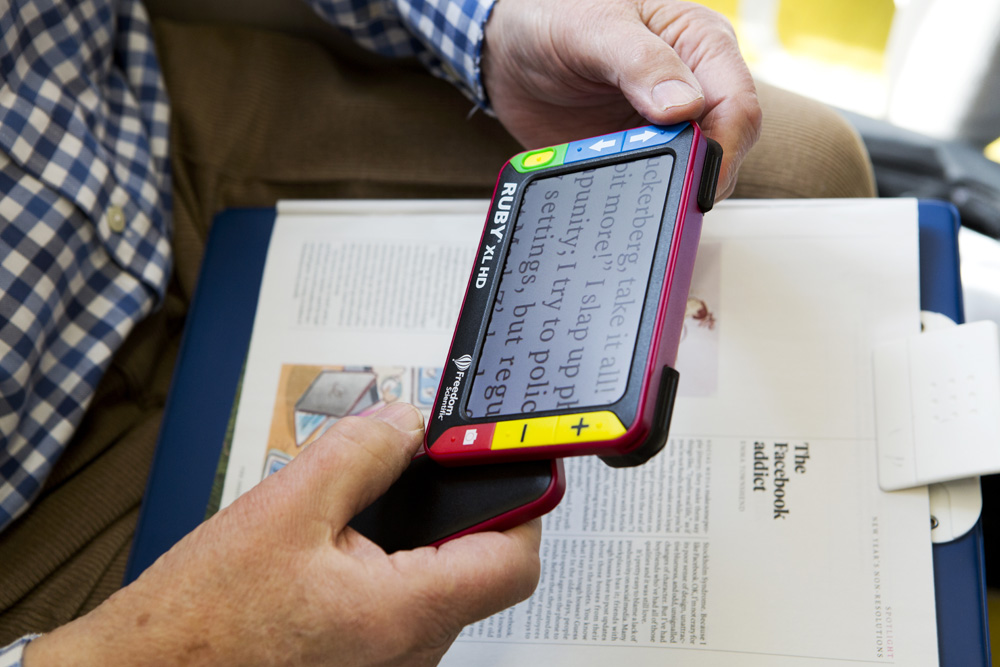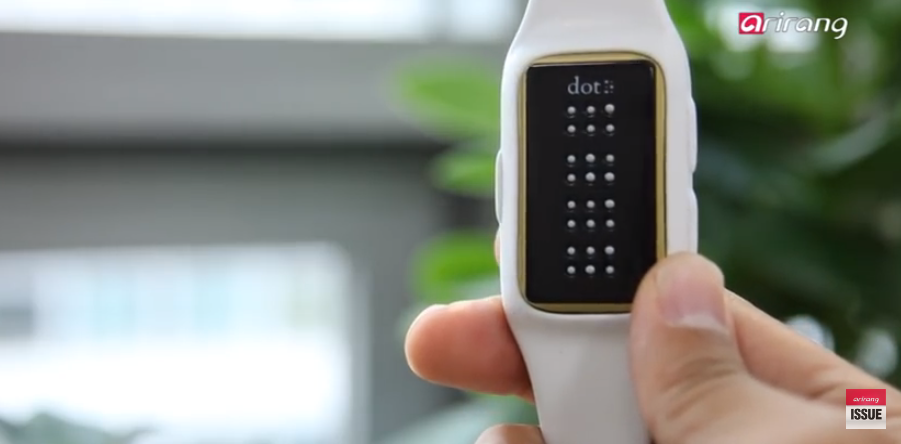AI-Powered Visual Aids: Transforming Support for the Blind
AI-Powered Visual Aids: Transforming Support for the Blind
Blog Article
Discover Cutting-edge Devices Designed for the Aesthetically Impaired
The advancement of ingenious devices for the visually damaged represents a significant improvement in access and freedom. Technologies such as clever glasses with AI abilities and mobile applications created to supply auditory descriptions are improving daily experiences for users. In addition, wearable gadgets that employ haptic comments enhance environmental understanding, while modern-day Braille technologies offer brand-new ways to involve with message. As these tools remain to progress, their impact on the lives of those with aesthetic problems raises important inquiries regarding the future of inclusivity and freedom in numerous aspects of life. What lies ahead in this technological landscape?
Smart Glasses for Navigating

Smart glasses developed for navigating are changing the method visually impaired individuals interact with their setting. These advanced gadgets utilize a combination of cam innovation, expert system, and acoustic feedback to offer real-time info regarding surroundings. By employing challenge discovery systems, clever glasses can inform customers to prospective risks, allowing more secure mobility in both familiar and unfamiliar settings.
The combination of GPS innovation further enhances navigation abilities, enabling users to get acoustic directions as they move. This hands-free strategy not just fosters self-reliance yet also equips aesthetically impaired individuals to navigate urban landscapes with raised confidence. Furthermore, several smart glasses are outfitted with features that identify sites and road signs, supplying contextual details that improves the individual experience.
Additionally, the development of these gadgets is continually advancing, with firms functioning to improve the accuracy of object recognition and increase the variety of navigational functions. As smart glasses become much more economical and available, they hold the potential to considerably transform day-to-day live for aesthetically damaged users. Ultimately, these ingenious tools stand for a crucial step toward inclusivity, offering boosted mobility and a greater sense of autonomy for individuals navigating the globe around them.

Mobile Apps for Daily Living
Exactly how can mobile applications enhance the lives of aesthetically impaired individuals? Mobile apps are reinventing the method aesthetically impaired individuals browse their environments, handle day-to-day tasks, and gain access to info. These applications supply crucial support through numerous functionalities, fostering independence and improving top quality of life.
Numerous ingenious mobile applications are made specifically for daily living. As an example, applications like Be My Eyes link visually damaged customers with sighted volunteers by means of video telephone calls, enabling them to obtain real-time help with tasks such as reading tags or navigating unknown spaces. Similarly, Seeing AI, developed by Microsoft, uses synthetic intelligence to explain surroundings, read message, and recognize things, properly changing a smartphone into an effective device for everyday support.
In addition, navigation applications customized for the visually impaired, such as Aira and BlindSquare, supply audio-based instructions and ecological info, enabling customers to traverse their surroundings safely and confidently. Past navigation and instant help, mobile apps additionally sustain organization and task management, with attributes that aid users establish pointers, develop to-do checklists, and track visits. In recap, mobile applications offer as essential resources, equipping aesthetically impaired individuals to lead more independent and meeting lives.
Wearable Technologies for Support
Empowerment via innovation is increasingly obvious in the realm of wearable devices developed to aid visually impaired individuals. These innovative devices integrate flawlessly right into daily life, enhancing navigating and giving necessary responses to customers. For circumstances, wise glasses outfitted with cameras can recognize faces and check out text out loud, permitting users to communicate even more with confidence in social and specialist settings.
One more notable improvement is using haptic comments systems in wearable devices. These systems utilize resonances or other tactile signals to convey information concerning the customer's atmosphere, such as obstacles or changes in terrain, improving mobility and safety and security. Wearable innovations likewise include wristbands that attach to smart devices, notifying users to alerts through refined vibrations, hence boosting connection without reliance on visual hints.
As these modern technologies continue to advance, they are not only improving self-reliance for visually damaged people yet likewise fostering a higher sense of incorporation in culture. By bridging the gap in between obstacles encountered in everyday living and the potential for freedom, wearable innovations work as critical tools in the pursuit for equal rights and empowerment for those with visual impairments.
Audio Description Devices
Audio summary tools play a vital role in clear eyeglasses enhancing access for aesthetically damaged people, supplying them with the ability to involve with aesthetic media. OCR devices for the blind. These tools use narrated descriptions of crucial aesthetic aspects in films, tv programs, and live performances, making certain that individuals can completely understand the context and emotions shared through visuals
Sound description can be incorporated right into various platforms, consisting of streaming solutions, movie theater screenings, and live movie theater. Numerous prominent streaming solutions now include audio summary as an ease of access attribute, allowing audiences to choose it quickly. In enhancement to conventional media, specialized apps likewise exist, offering audio summaries for art events, museums, and other cultural occasions.
The performance of audio description hinges on the ability of the storytellers, that must communicate aesthetic information succinctly without taking away from the initial audio. Advancements in this field are likewise leading the means for even more tailored experiences, where users can adjust the degree of information and pacing according to their choices.
Braille Innovations and Instruments
Braille here are the findings developments and tools have actually considerably transformed the method aesthetically impaired people engage with message and information. Modern developments have led to the development of versatile tools that improve literacy and independence among users.
Furthermore, portable Braille notetakers integrate traditional Braille input with modern functionalities, helping with note-taking, scheduling, and file modifying on the go. AI-powered visual aids. These small gadgets frequently feature text-to-speech capabilities, linking the void between Braille and auditory information
Additionally, ingenious Braille printers have actually emerged, allowing customers to create Braille labels, documents, and instructional products effectively. This availability promotes greater engagement in academic and professional atmospheres, inevitably advertising inclusivity.
Moreover, research study into clever Braille innovations proceeds to expand. Tools that incorporate man-made intelligence are being discovered to supply real-time navigating help and contextual information, enhancing the user experience in varied settings. Overall, these innovations mirror a commitment to encouraging visually damaged individuals with technology, guaranteeing they can easily gain access to and engage with the globe around them.

Final Thought
The development of innovative tools for the aesthetically impaired considerably enhances freedom and top quality of life. Smart glasses, mobile applications, wearable technologies, audio summary tools, and Braille innovations jointly equip individuals by giving important navigation aid, environmental understanding, and improved analysis experiences. These innovations not just foster better incorporation yet likewise advertise freedom in daily tasks, eventually adding to a much more equitable and obtainable society for aesthetically damaged people. Continued growth in this field holds assurance for additional improvements.
As smart glasses become a lot more economical and obtainable, they hold the potential to significantly change day-to-day life for visually damaged customers. Mobile apps are reinventing the method aesthetically damaged Resources users browse their settings, manage daily tasks, and access info. Applications like Be My Eyes attach visually damaged customers with sighted volunteers via video clip phone calls, enabling them to obtain real-time aid with jobs such as reading labels or navigating unknown areas.Furthermore, navigating applications customized for the aesthetically damaged, such as Aira and BlindSquare, use audio-based instructions and ecological info, making it possible for customers to traverse their environments securely and confidently.The improvement of innovative devices for the aesthetically damaged substantially improves self-reliance and high quality of life.
Report this page